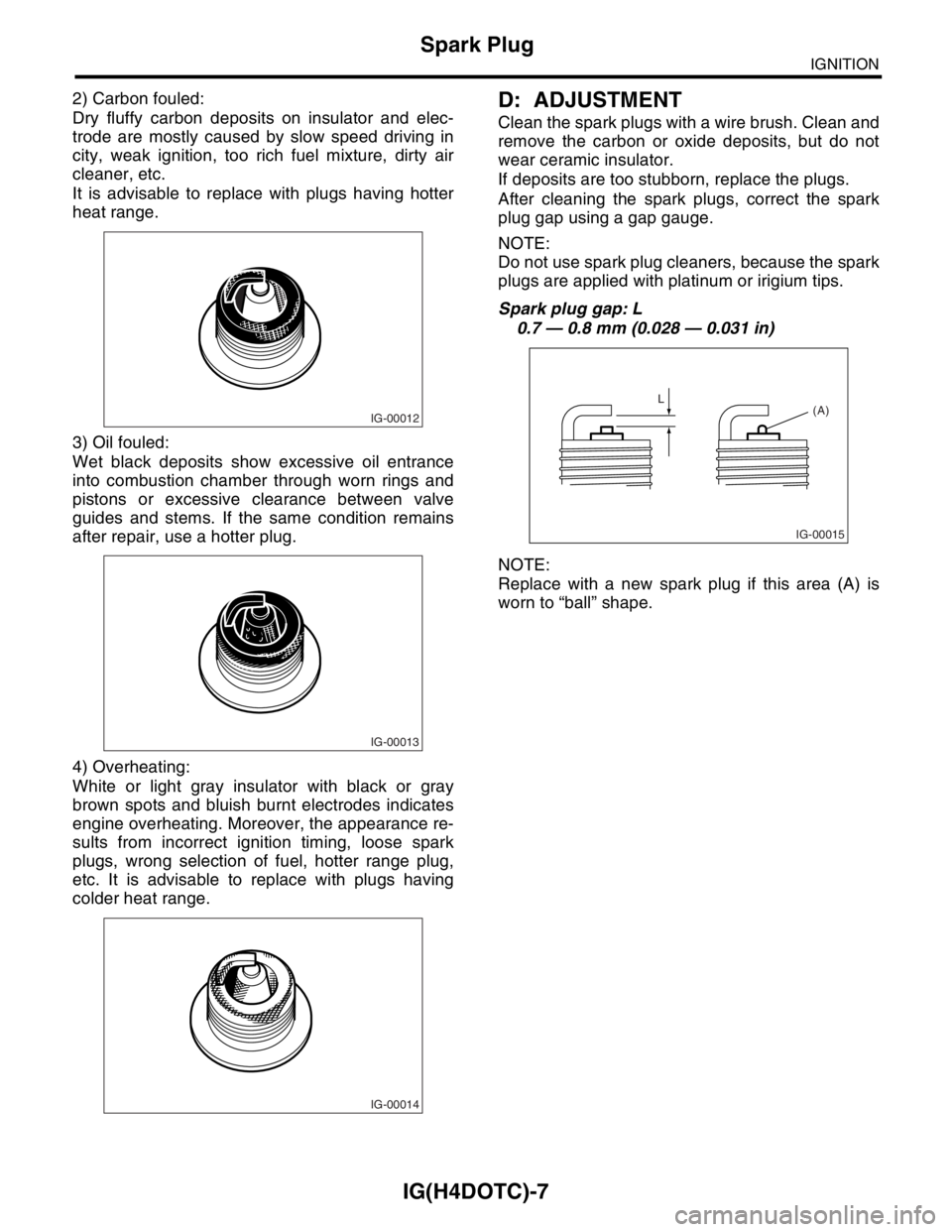Page 1581 of 2870

ME(H4DOTC)-121
MECHANICAL
Engine Trouble in General
5. Engine does not return to
idle.Engine control system A
Intake system Loosened or cracked vacuum hose A
Others Stuck or damaged throttle valve A
Accelerator cable out of adjustment (2.0 L model) B
6. Dieseling (Run-on) Engine control system A
Cooling system Overheating B
Others Malfunction of evaporative emission control system B
7. Afterburning in exhaust
systemEngine control system A
Intake system Loosened or cracked intake duct C
Loosened or cracked PCV hose C
Loosened or cracked vacuum hose B
Defective PCV valve B
Loosened oil filler cap C
Belt Defective timing B
Compression Incorrect valve clearance B
Loosened spark plugs or defective gasket C
Loosened cylinder head bolts or defective gasket C
Improper valve seating B
Defective valve stem C
Worn or broken valve spring C
Worn or stuck piston rings, cylinder and piston C
Incorrect valve timing A
Lubrication system Incorrect oil pressure C
Cooling system Over cooling C
Others Malfunction of evaporative emission control system C
8. Knocking Engine control system A
Intake system Loosened oil filler cap B
Belt Defective timing B
Compression Incorrect valve clearance C
Incorrect valve timing B
Cooling system Overheating A
9. Excessive engine oil con-
sumptionIntake system Loosened or cracked PCV hose A
Defective PCV valve B
Loosened oil filler cap C
Compression Defective valve stem A
Worn or stuck piston rings, cylinder and piston A
Lubrication system Loosened oil pump attaching bolts and defective gas-
ketB
Defective oil filter o-ring B
Defective crankshaft oil seal B
Defective rocker cover gasket B
Loosened oil drain plug or defective gasket B
Loosened oil pan fitting bolts or defective oil pan B TROUBLE PROBLEM PARTS, ETC. POSSIBLE CAUSE RANK
Page 1582 of 2870
ME(H4DOTC)-122
MECHANICAL
Engine Trouble in General
10. Excessive fuel consump-
tionEngine control system A
Intake system Dirty air cleaner element A
Belt Defective timing B
Compression Incorrect valve clearance B
Loosened spark plugs or defective gasket C
Loosened cylinder head bolts or defective gasket C
Improper valve seating B
Defective valve stem C
Worn or broken valve spring C
Worn or stuck piston rings, cylinder and piston B
Incorrect valve timing B
Lubrication system Incorrect oil pressure C
Cooling system Over cooling C
Others Accelerator cable out of adjustment (2.0 L model) B TROUBLE PROBLEM PARTS, ETC. POSSIBLE CAUSE RANK
Page 1583 of 2870

ME(H4DOTC)-123
MECHANICAL
Engine Noise
26.Engine Noise
A: INSPECTION
NOTE*:
When disconnecting the fuel injector connector, Malfunction Indicator Light illuminates and DTC is stored in
ECM memory.
Therefore, carry out the CLEAR MEMORY MODE
Mode.> and INSPECTION MODE after con-
necting the fuel injector connector.
Type of sound Condition Possible cause
Regular clicking soundSound increases as engine
speed increases. Valve mechanism is defective.
Incorrect valve clearance
Worn valve rocker
Worn camshaft
Broken valve spring
Heavy and dull clankOil pressure is low. Worn crankshaft main bearing
Worn connecting rod bearing (big end)
Oil pressure is normal. Loose flywheel mounting bolts
Damaged engine mounting
High-pitched clank (Spark
knock)Sound is noticeable when
accelerating with an overload. Ignition timing advanced
Accumulation of carbon inside combustion chamber
Wrong heat range of spark plug
Improper octane number of gasoline
Clank when engine speed is
medium (1,000 to 2,000 rpm).Sound is reduced when fuel
injector connector of noisy cyl-
inder is disconnected.
(NOTE*) Worn crankshaft main bearing
Worn bearing at crankshaft end of connecting rod
Knocking sound when engine
is operating under idling speed
and engine is warmSound is reduced when fuel
injector connector of noisy cyl-
inder is disconnected.
(NOTE*) Worn cylinder liner and piston ring
Broken or stuck piston ring
Worn piston pin and hole at piston end of connecting rod
Sound is not reduced if each
fuel injector connector is dis-
connected in turn. (NOTE*) Unusually worn valve lifter
Worn cam gear
Worn camshaft journal bore in crankcase
Squeaky sound — Insufficient generator lubrication
Rubbing sound — Defective generator brush and rotor contact
Gear scream when starting
engine— Defective ignition starter switch
Worn gear and starter pinion
Sound like polishing glass with
a dry cloth— Loose drive belt
Defective water pump shaft
Hissing sound — Loss of compression
Air leakage in air intake system, hoses, connections or mani-
folds
Timing belt noise — Loose timing belt
Belt contacting case/adjacent part
Valve tappet noise — Incorrect valve clearance
Page 1621 of 2870
IG(H4DOTC)-5
IGNITION
Spark Plug
2. Spark Plug
A: REMOVAL
CAUTION:
All spark plugs installed on an engine, must be
of the same heat range.
General Description.>
1. RH SIDE
1) Disconnect the ground cable from battery.
2) Remove the air cleaner lower case.
IN(H4DOTC)-7, REMOVAL, Air Cleaner.>
3) Disconnect the connector from ignition coil.
4) Remove the ignition coil.5) Remove the spark plugs with the spark plug
sockets.
2. LH SIDE
1) Disconnect the battery cables, and then remove
the battery and battery carrier.
2) Disconnect the washer motor connector.
3) Disconnect the rear window glass washer hose
from washer motor, then plug connection with a
suitable cap.
4) Remove the two bolts which hold washer tank,
then take the tank away from working area.
FU-00009
FU-01307
IG-00003
IG-00004
FU-00009
IG-00005
IG-00006
Page 1623 of 2870

IG(H4DOTC)-7
IGNITION
Spark Plug
2) Carbon fouled:
Dry fluffy carbon deposits on insulator and elec-
trode are mostly caused by slow speed driving in
city, weak ignition, too rich fuel mixture, dirty air
cleaner, etc.
It is advisable to replace with plugs having hotter
heat range.
3) Oil fouled:
Wet black deposits show excessive oil entrance
into combustion chamber through worn rings and
pistons or excessive clearance between valve
guides and stems. If the same condition remains
after repair, use a hotter plug.
4) Overheating:
White or light gray insulator with black or gray
brown spots and bluish burnt electrodes indicates
engine overheating. Moreover, the appearance re-
sults from incorrect ignition timing, loose spark
plugs, wrong selection of fuel, hotter range plug,
etc. It is advisable to replace with plugs having
colder heat range.D: ADJUSTMENT
Clean the spark plugs with a wire brush. Clean and
remove the carbon or oxide deposits, but do not
wear ceramic insulator.
If deposits are too stubborn, replace the plugs.
After cleaning the spark plugs, correct the spark
plug gap using a gap gauge.
NOTE:
Do not use spark plug cleaners, because the spark
plugs are applied with platinum or irigium tips.
Spark plug gap: L
0.7 — 0.8 mm (0.028 — 0.031 in)
NOTE:
Replace with a new spark plug if this area (A) is
worn to “ball” shape.
IG-00012
IG-00013
IG-00014
IG-00015
L
(A)
Page 1633 of 2870
EN(H4DOTC)-3
ENGINE (DIAGNOSTIC)
Basic Diagnostics Procedure
2. AUTOMATIC TRANSMISSION
When the DTC about automatic transmission is
shown on display, carry out the following basic
check.After that, carry out the replacement or re-
pair work.
1) ATF level check
Transmission Fluid.>
2) Differential gear oil level check
Differential Gear Oil.>
3) ATF leak check
Transmission Fluid.>
4) Differential gear oil leak check
Differential Gear Oil.>
5) Stall Test
6) Line Pressure Test
sure Test.>
7) Transfer Clutch Pressure Test
Transfer Clutch Pressure Test.>
8) Time Lag Test
9) Road Test
10) Shift characteristics
Clutch Pressure Test.>
Page 1635 of 2870

EN(H4DOTC)-5
ENGINE (DIAGNOSTIC)
Check List for Interview
2. CHECK LIST NO. 2
Check the following items about the vehicle’s state when malfunction indicator light turns on.
NOTE:
Use copies of this page for interviewing customers.
a) Other warning lights or indicators turn on. ❏ Yes / ❏ No
❏ Low fuel warning light
❏ Charge indicator light
❏ AT diagnostic indicator light
❏ ABS Warning Light
❏ Oil pressure indicator light
b) Fuel level
Lack of gasoline: ❏ Yes / ❏ No
Indicator position of fuel gauge:
Had run out of gas before: ❏ Ye s / ❏ No
c) Intentional connecting or disconnecting of harness connectors or spark plug cords: ❏ Yes / ❏ No
What:
d) Intentional connecting or disconnecting of hoses: ❏ Ye s / ❏ No
What:
e) Installing of other parts except genuine parts: ❏ Ye s / ❏ No
What:
Where:
f) Occurrence of noise: ❏ Yes / ❏ No
From where:
What kind:
g) Occurrence of smell: ❏ Yes / ❏ No
From where:
What kind:
h) Intrusion of water into engine compartment or passenger compartment: ❏ Yes / ❏ No
i) Troubles occurred
❏ Engine does not start.
❏ Engine stalls during idling.
❏ Engine stalls while driving.
❏ Engine speed decreases.
❏ Engine speed does not decrease.
❏ Rough idling
❏ Poor acceleration
❏ Back fire
❏ After fire
❏ Does not shift.
❏ Excessive shift shock
Page 1646 of 2870
EN(H4DOTC)-16
ENGINE (DIAGNOSTIC)
Electrical Component Location
SOLENOID VALVE, ACTUATOR, EMISSION CONTROL SYSTEM PARTS AND IGNITION SYSTEM
PARTS
(1) Wastegate control solenoid valve (4) Ignition coil (7) Injector
(2) Idle air control solenoid valve (5) Tumble generator valve actuator
(3) Purge control solenoid valve (6) Oil frow control solenoid valve
EN-02406
(2)
(5)(4) (1)
(5)
(3)
(6)
(7)
(7) (6)